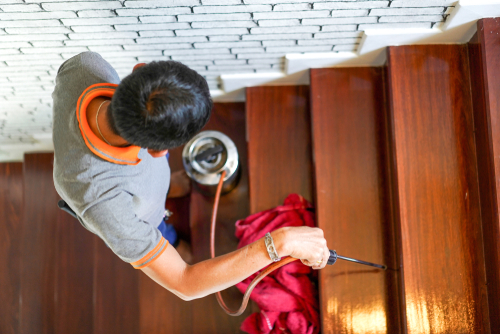
Some Magical Tips and Tricks for Termite Control
May 21, 2020
How Much Does It Cost For Termite Treatment In Singapore?
July 15, 20207 Things About Dry-wood Termite Treatment

7 Things About Dry-wood Termite Treatment – No doubt that every homeowner would like to live in a secure home free from dry-wood termites. If you are one of them, the question goes, is your home safe from dry-wood termites? Many would get it wrong. Why?
If you have not inspected your home, you could be living with hundreds of dry-wood termites. Interestingly, dry-wood termites are a lot cleverer than you may think. The dry-wood termites can easily give you a false feeling of being confident that you are secure. And worse, they may be having their way with the woods that make up your home.
When the dry-wood termites infest your home, they cause extensive damage. They chew tunnels inside wooden beams and other wooden objects weakening them from inside. Drywood termites detected on time can be controlled through fumigation. If not, then you will have to do a home repair, which is a costly expenditure
As a homeowner, you need to familiarize yourself with the signs of drywood infested woods and ways of treating them.
The following are signs of an infested wooden structure.

- Mud tunnel tubes
- Woods that sound hollow
- Flying termites and discarded wings
- Clicking sounds on the woods
- White ants
- Stiff doors to open and close
With the knowledge of the signs, you may want to know how to treat drywood termites.
Is drywood termites treatment necessary?

Unlike other pests that feed on food sources from inside your home, dry-wood termites consume wood. This means that if not treated the dry-wood termites will live in your home for years.
There are two broad ways in which you can treat dry-wood termites in your home.
- Non –chemical treatment method
- Chemical treatment method
A. Non-Chemical Treatment.

- Use of physical barrier.
This method involves the application of non-chemical substances such as steel mesh and particles of sand. Drywood termites find it challenging to go past steel mesh and sands of particular sizes.
- Biological control agents
Biological control agents such as nematodes and fungi are used to treat drywood termites. Though the method is not scientifically approved, it has shown great success in regulating drywood termites. They are also considred to be environmental friendly.
- Removal and replacement of infested wood.
Removal and replacement of infested wood are one of the easiest ways to get rid of dry-wood termites. But this method can only be effective when the dry-wood termites have infested only one or two pieces of wood. If the dry-wood termites have gone beyond that, it may be expensive.
B.The Chemical Treatment Method.

This method involves the use of chemicals to treat drywood termites.
It is worth noting that you should only use pesticides that have been approved scientifically for treating dry-wood termites. Also, remember to use the pesticide per the label directions to avoid risks.
The approved treatment for drywood termites includes:
- Liquid soil-applied termiticides.
- Termite baits.
- Building materials impregnated with termiticides.
- Wood treatments.
Use of liquid soil-applied termiticides.

In this method, the chemical is prayed around the structure to repel drywood termites from the structure. When the drywood termites lack moisture they die.
One of the shortcomings in this method is those drywood termites already in the structure will not leave the structure.
Use of termite baits

Baits are edibles that are deployed for the dry-wood termites to eat. When they eat the baits and share with their mates, the result will be a decline in population for most of them would die.
The baits consist of cellulose combined with insecticide.

Building material impregnated with termiticides. During the construction, the concrete foundation is used that leaves ventilation between the wood and the soil. This reduces dry-wood termites’ access to the structure.
Wood treatment

Borate is sprayed on the wood during new home construction to keep away drywood termites. The chemical keeps away the termites, thus no infestation.
7 Things About Dry-wood Termite Treatment –
Conclusion
When treating a home that is infested by dry-wood termites, it is good to follow the following guidelines
- Identify correctly the infested areas.
- Sweep away all the dry-wood frass
- Make small holes on the affected areas
- Use a pump and generator to pump the termiticides into the drilled holes.




